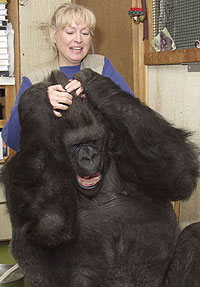An ethologist colleague, Jonathan Balcombe, Ph.D., wrote recently requesting material for his book on animal pleasure. He believes that such a book would strengthen society’s sense of moral responsibility toward other animals. DeeAnn Draper, a gorilla caregiver and food preparation manager, submitted the following observations and I wanted to share them with you: ‘The obvious and continuous demonstrations of gorilla pleasure occur at the anticipation or sight of food. The more subtle, non-food-involved demonstrations of pleasure usually have to do with play behavior or, in Koko’s and Michael’s case, laughter at funny or fun activities or situations. ‘Gorillas can laugh uncontrollably when they are tickled (see Koko photo). Ndume purrs when I scratch his back. ‘In my mind, I often replay an exchange Ndume and I had, just sitting in his room. Ndume has quite a sense of fun. I was sitting in the hall while he sat in his B room. Both of us had our backs to the west wall. We were looking at each other sideways, when I quickly did a head turn and looked straight ahead. I slowly turned my head back toward Ndume, and noticed a slight grin on his face. Then he did a quick head turn to look straight ahead, his grin widening. I copied him. We slowly turned back toward each other, his grin now a smile. We repeated this twice more, each time his smile got bigger. The last time we turned back toward each other, he purred and stomped his feet on the ground. ‘While playing with Michael indoors, we would often play tug or a little game of chase. He was a completely different gorilla indoors in comparison to his demeanor outdoors. Outdoors he was in charge, often patrolling the yards, alert to any noises in the surrounding forest, road or even the houses across the road. In other words, he was serious and on the job. He would play chase with us and be a little playful, but nothing in comparison with his indoor behavior. ‘Indoors, Michael would feed one end of a blanket to us through the mesh. He would only pull on the blanket as hard as the person on the other end. Of course he could easily take the blanket if he wanted to, but the game lasted much longer if he showed restraint – and he did. I remember one indoor play session in particular that started like many others, with a game of tug. Michael gave me one end of a soft blanket, then started his play invitation/enjoyment gesture – ‘bite-palm.’ His various play invitation/enjoyment gestures were: sham chewing on the heel of his hand, on his thumb, on his wrist or even the back of his hand occasionally. He really got into the game that day, tugging and chewing, chewing and tugging. Then he started to laugh. He laughed continuously for about 10 minutes as we tugged. He got me laughing and we fed off each other’s joyous mood for quite some time. This is the type of behavior that most people, even people who work with gorillas for years, never see. ‘Koko has another dimension to her enjoyment. Since Koko understands English as well as sign language, she has fun with sounds. She likes rhyming poetry, makes plays on words (ie. Koko + nut = coconut) and makes jokes (ie. putting a straw to her nose and calling herself a ‘thirsty elephant’). She also laughs at slap-stick humor (eg, we do something clumsy like trip or drop something). She always seems to get a chuckle out of us making comments about Ndume (or Michael) getting into trouble.’ DeeAnn’s observations seem especially resonant to me today, after just returning from the ChimpanZoo Conference, where I and several other ape language and behavior researchers compared notes and reports about the propensity of apes to play. This is clearly something we have in common with the other great apes, and the more we observe them, the more we remember what’s really important in life. Penny PS: Stay tuned for a funny little video clip featuring Koko and me playing. We’ll put a link on this page, the Koko.org homepage and on KokoTV, when it’s ready.
Gorillas Just Wanna Have Fun
Created On:
Posted On:


